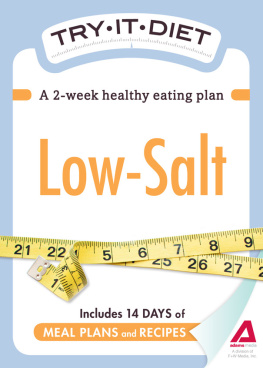
Try-It Diet: Diabetes Diet
A two-week healthy eating plan
Adams Media, an imprint of Simon & Schuster, Inc.

Avon, Massachusetts
Contents
Introduction
A Try-It Diet is just that a diet that you can try out for two weeks to see if it is a good fit for you. Keep in mind that not every diet is right for every person; please consult with your doctor before making radical changes to your diet. Whether you have just been diagnosed with diabetes or you have dealt with it for many years, there are steps you can take to manage it effectively. A daily plan for diabetes includes a healthy eating plan, exercise, and possibly medication. Learning more about healthy eating habits and ways to prepare tasty, enjoyable foods can help you start making those changes. As you make small changes to your eating habits, youll soon realize that you can have more control over your diabetes.
Work closely with your doctor and dietitian to learn how healthy eating and lifestyle changes can make a big difference in achieving better health and better diabetes control. Contrary to what you may have heard in the past, there is no strict diet you must follow. You will likely need to make some changes in your lifestyle, and sometimes changes can seem very difficult. It is usually not necessary to totally change everything about the way that you eat. Managing diabetes is more about adopting a healthier lifestyle by making small changes one at a time. The American Association of Diabetes Educators believes that the seven self-care behaviors shown below are effective ways to make positive changes:
- Eat healthy: Make healthy food choices, understand portion sizes, and learn the best times to eat.
- Be active: Include regular activity for overall fitness, weight management, and blood glucose control.
- Monitor: Self-monitor your blood glucose daily to assess how food, physical activity, and medications are working.
- Take medication: Understand how medications work, and when to take them.
- Problem solve: Know how to problem solve.
For example, a high or low blood glucose episode requires the ability to make a quick decision about food, activity, or medication.
- Reduce risks: Effective risk-reduction behaviors such as smoking cessation and regular eye exams are examples of self-care that reduce risk of complications.
- Healthy coping: Good coping skills that deal with the challenges of diabetes help you stay motivated to keep your diabetes in control.
You may think that having diabetes means giving up everything you like to eat, especially carbohydrates. Nothing could be further from the truth! With the help and advice of a registered dietitian, you can adopt healthy eating habits that fit into your lifestyle. Snacking is a great way to prevent excessive hunger and keep your blood sugar at a healthy level. When chosen wisely, snacks can help you work in the recommended amounts of healthful foods such as fruit or vegetables. Trying new foods can expand the options of foods in your eating plan. Today there are many more choices of whole or minimally processed foods available to the consumer.
Shopping in the produce section of the grocery store or visiting your local farmers market can give you plenty of ideas for including some foods that you may not have used before. Large grocery stores and health food stores carry an array of different whole-grain products that, while not new, may be unfamiliar to you. Accept that you wont be able to change your eating habits overnight, and adopt the approach of taking small steps every day. Over time, you can make significant changes toward improving your health and reaching consistent near-normal blood glucose levels. Think of changes in your eating habits as goals rather than inflexible rules and regulations. Start by making an honest review of your current eating habits then list what youd like to change or improve.
Decide exactly how you will work on each change then select one or two changes to work on at a time. Your dietitian can help you with creative ideas for making changes. Heres an example: If you eat a candy bar as a pick-me-up late in the afternoon, try substituting a small piece of fruit and an ounce of low-fat cheese instead. You may be surprised to learn that your eating plan will have the same foods that everyone else eats, and buying all sorts of specialty or diet foods is usually unnecessary. You may wish to use an artificial sweetener of your choice or certain sugar-free food items; however, this is not essential. You will not have to prepare one meal for yourself and something different for the rest of your household.
As you look over the recipes in this cookbook, you will find a few specialty items, but in general the recipes use foods that everyone can eat. If youd like to explore the diabetes diet in more detail, check out The Everything Diabetes Cookbook , 2nd Edition available in print (ISBN: 978-1-4405-0154-8) and eBook (eISBN: 978-1-4405-0155-5) formats.
Weekly Meal Plans
Week 1
Sunday
Breakfast
Lunch
Dinner
Dessert
Monday
Breakfast
Lunch
Snack
Dinner
Tuesday
Breakfast
Lunch
Snack
Dinner
Wednesday
Breakfast
Lunch
Snack
Dinner
Thursday
Breakfast
Lunch
Snack
Dinner
Friday
Breakfast
Lunch
Snack
Dinner
Saturday
Breakfast
Lunch
Dinner
Dessert
Week 2
Sunday
Breakfast
Lunch
Dinner
Dessert
Monday
Breakfast
Lunch
Snack
Dinner
Tuesday
Breakfast
Lunch
Snack
Dinner
Wednesday
Breakfast
Lunch
Snack
Dinner
Thursday
Breakfast
Lunch
Snack
Dinner
Friday
Breakfast
Lunch
Snack
Dinner
Saturday
Breakfast
Lunch
Dinner
Dessert
Country-Style Omelet Serves 2

Ingredients 2 teaspoons olive oil 1 cup zucchini, diced cup red pepper, diced 1 cup plum tomatoes, skinned and cubed teaspoon pepper 4 eggs 1 tablespoon Parmesan cheese 1 teaspoon fresh basil, minced
- Heat oil in nonstick skillet. Add zucchini and red pepper; saut for 5 minutes.
- Add tomatoes and pepper; cook uncovered for another 10 minutes, allowing fluid from tomatoes to cook down.
Next page




















 Avon, Massachusetts
Avon, Massachusetts  Ingredients 2 teaspoons olive oil 1 cup zucchini, diced cup red pepper, diced 1 cup plum tomatoes, skinned and cubed teaspoon pepper 4 eggs 1 tablespoon Parmesan cheese 1 teaspoon fresh basil, minced
Ingredients 2 teaspoons olive oil 1 cup zucchini, diced cup red pepper, diced 1 cup plum tomatoes, skinned and cubed teaspoon pepper 4 eggs 1 tablespoon Parmesan cheese 1 teaspoon fresh basil, minced